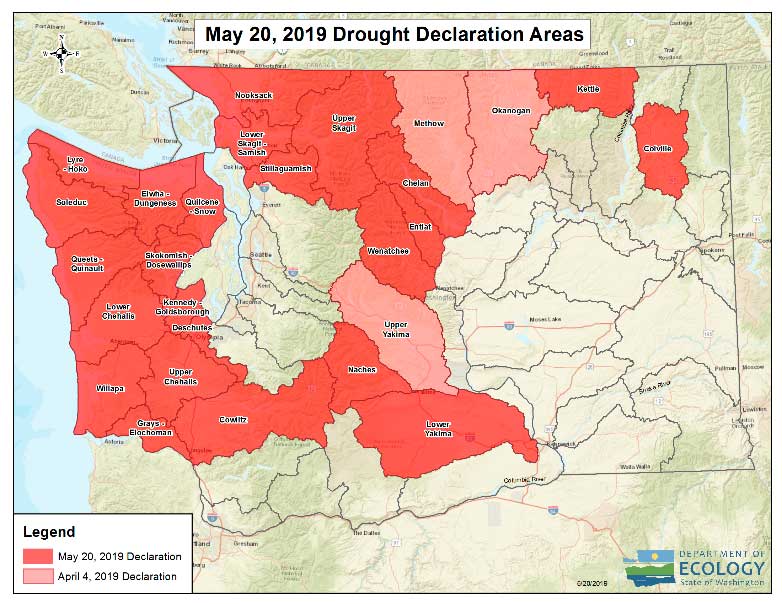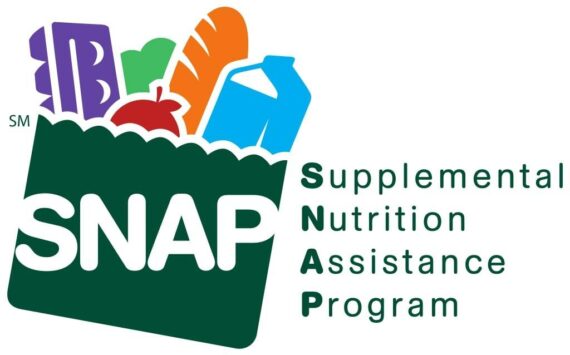Gov. Jay Inslee expanded the drought emergency declaration to cover nearly half of Washington state due to worsened, poor water supply conditions around the state and warmer and drier weather predictions through the summer.
Snow pack conditions are currently less than 50 percent of average for this time of year. Washington State Department of Ecology experts expect the warmer, drier weather will cause the already-diminished snow pack to melt more quickly, reducing water availability this summer when it is needed most for farms, communities and fish. Despite this past week’s rain, rainfall totals for the state remain below normal.
The following 24 watersheds are now added to the emergency drought declaration:
Chelan, Colville, Cowlitz, Deschutes, Elwha-Dungeness, Entiat, Grays-Elochoman, Kennedy-Goldsborough, Kettle, Lower Chehalis, Lower Skagit-Samish, Lower Yakima, Lyre-Hoko, Naches, Nooksack, Queets-Quinault, Quilcene-Snow, Skokomish-Dosewallips, Soleduc, Stillaguamish, Upper Chehalis, Upper Skagit, Wenatchee, and Willapa.
The governor announced the initial emergency drought declaration April 4 for the Methow, Okanogan and Upper Yakima basins.
“I appreciate Ecology’s work with partners around the state to prepare for drought and to position us to quickly react to those in need,” said Inslee. “As the climate continues to change, we must be proactive in taking steps to plan for those impacts.”
Residents served by the Seattle, Everett and Tacoma regional water systems can be assured that their water supplies are in much better shape. These public utilities report that they have sufficient water supply for people and fish this summer. Their water managers are watching the weather forecasts and encourage customers to continue to use water wisely.
“The emergency declaration allows us to expedite emergency water right permitting and make funds available to government entities to address hardships caused by drought conditions,” said Ecology Director Maia Bellon.
The 2019 Legislature appropriated $2 million for drought response. Ecology anticipates funding for public agencies for drought response will be available in early June.
There are two factors considered for any emergency drought declaration: Water supply conditions that are currently or projected to be at or below 75 percent of average, and a projection of undue hardships. The state last declared a drought emergency in 2015.
You can access several resources on Ecology’s website at ecology.wa.gov/drought. You can also report drought-related conditions to the National Drought Mitigation Center. https://www.drought.gov/drought/states/washington?
– Washington Department of Ecology
_______________________
Take steps now to plan for wildfire smoke, poor air quality
As summer and dry weather approaches, officials at the Washington State Department of Health are urging everyone in Washington to prepare for smoky days with unhealthy air quality.
What people can do now:
Identify air quality reports for your area. The Washington Smoke Information Blog has a map of current fires and air quality reports statewide. EPA’s Smoke Sense mobile app has location-specific information on smoke and health impacts.
If you or a family member has heart or lung disease, including asthma, ask your doctor what precautions should be taken when air quality is impacted by smoke. Have necessary medication and recommended supplies on hand.
Buy a portable air cleaner with a high efficiency HEPA filter and create a “clean” room to spend time in when the air isn’t healthy. Select a room with no fireplace, and few windows and/or doors.
Find information about health impacts from smoke and more tips on how to stay healthy when smoke levels are high on the department’s website.
While breathing smoke isn’t good for anyone, some people are more likely to have health problems when air quality isn’t good. Sensitive groups include children under 18 and adults over 65, people with heart and lung diseases, people with illnesses and colds, people who have had a stroke, pregnant women and people who smoke. It is especially important for these people to reduce exposures by limiting outdoor activity and staying indoors with cleaner air when it’s smoky outside.
Symptoms from exposure to smoky air can range from minor to life-threatening and include watery or dry eyes, coughing or wheezing, throat and sinus irritation, phlegm, shortness of breath, headaches, irregular heartbeat and chest pain. People experiencing serious symptoms should seek medical attention immediately.
– Washington State Department of Health









